This was published 7 years ago
River cruise, to Bagan, Myanmar: Take the Irrawaddy into a completely different world
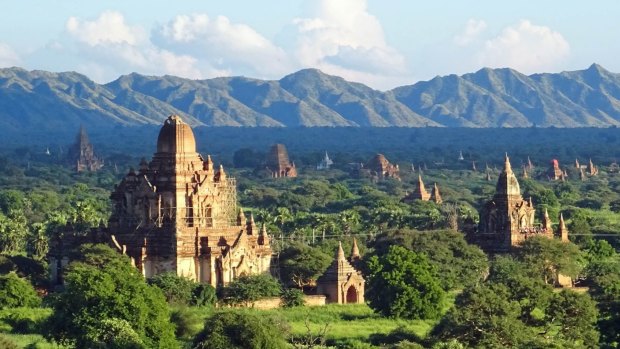
View over Bagan's temples from Sulamani Pagoda. Credit: Brian Johnston
By early morning we're sailing south, away from the cheerful chaos of Mandalay and into the soft wide landscapes of Myanmar. The Irrawaddy River is sluggish, fringed by trees shading lurking long-horned cattle. Spluttering barges and temporary farmers' huts – which are relocated to higher ground in the rainy season – are the only occasional signs of life. Across the floodplains, gentle blue hills shimmer in the tropical heat, and the golden spires of temples semaphore to our passing ship.
My ship Sanctuary Ananda is taut in teak and white trim, with interiors of retro indulgence that make me think I ought to have brought along my pith helmet and swagger stick. I sit on the open deck, fanned by a river breeze and propped up like a pasha on colourful silken cushions. It's a breezy, pretty space under retractable shades and Asian lanterns from which to view the passing river spectacle.
By next morning the landscape has rumpled upwards and turned vivid green. We tie up at the river's edge under banana trees for a shore excursion into the provincial town of Pakokku, which lies across the Irrawaddy via a three-kilometre bridge. Surrounded by rice paddies and tobacco fields, Pakokku is an agricultural centre of small shops and large markets. Traders' houses and monasteries are its most prominent buildings. In 2007, it was Pakokku's protesting monks that stirred up the widespread pro-democracy demonstrations that lead to Myanmar's Saffron Revolution.
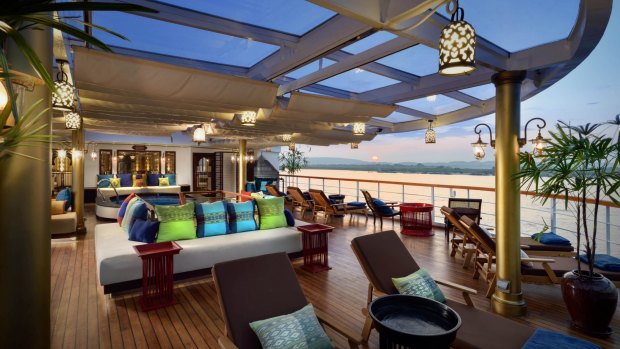
Sanctuary Ananda's sun deck at sunset.Credit: Ken Hayden
Our first stop is a cheroot manufactory, where ladies fold tobacco into leaves and roll them up with dexterous speed. They're paid by the piece and might expect to make $5 a day. Also interesting is the thanaka market, which trades the tree bark used to make the cosmetic paste that local women smear on their cheeks against the sun. Our Sanctuary Ananada guide Khin is alert to the tricks of country folk, pointing out that some of the bark has been painted. Darker, richer thanaka bark fetches a better price.
Pakokku's central market covers many city blocks in narrow alleyways where we often have to sidestep spice sacks and plastic buckets of vegetables. Pomelos the size of footballs hang from strings. Trestle tables are stacked with hacked-up lengths of sugarcane, bundles of cigars and heart-shaped betel leaves tied together with purple ribbon. Dried fish competes with nostril-twitching chilli powder and the rich smell of flyblown sweets made from sugarcane and turmeric.
We set sail again over lunch. Great sandy riverbanks are topped with a fringe of reeds, beyond which a vast valley stretches flat to distant hills. I tuck into the always excellent buffet lunch in the ship's restaurant, concentrating on the south-east Asian dishes: crispy morning glory with Thai tomyam dressing; spicy mango and pomelo salad; stir-fried pork loin with ginger.
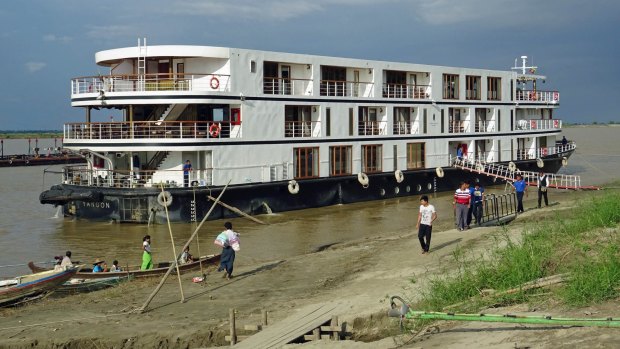
Intrepid exploration: The ship docked in Bagan. Credit: Brian Johnston
My coffee (and, admittedly, one too many dessert nibbles) is scarcely finished before we're tying up on a muddy riverbank outside Bagan, our port of call over the next few days. The lack of facilities in Bagan – as indeed in the rest of Myanmar – lends an air of intrepid exploration to our cruise. We scramble down a gangplank onto mudflats, and then have to navigate a narrow back street along which curries bubble in red-clay pots and old men mutter in ramshackle cafes.
Bagan, though really little more than an overgrown village, has a grand history, which we first encounter on a tour with our guide Khin to Shwezigon Pagoda. It's the first major monument built in what became the Burmese style, and served as a prototype for temples thereafter. Its beautiful golden stupa is surrounded by small shrines in which Buddha statues smile. Pilgrims come here from across Myanmar. They hit temple bells with a mallet, the bonging reverberations jumping from wall to wall, almost like the sound of doom rather than the "tinkly temple bells" of Kipling poetry.
As the sun starts to turn the landscape molten we arrive at the Kayminga Pagoda complex, just a small corner of the 2000 temple ruins scattered over 70 square kilometres of Bagan's vast plain on the eastern banks of the Irrawaddy. Bagan provides a giant pop-up book of Buddhist architecture, whose various styles we trace from the 11th to 13th centuries over the next two days. The dilapidated red-brick temples have remnants of carved facades now sprouting weeds, and sit amid a wild tangle of lush grasses, tamarind trees and overgrown bean fields.
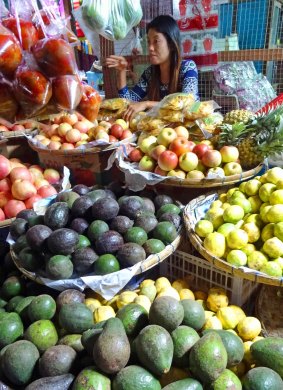
Fruit stall in the market in Old Bagan.Credit: Brian Johnston
Bagan's state of repair is sad but wonderfully atmospheric. This is one of the world's most fabulous architectural ensembles, and its lack of development and crowds makes it almost otherworldly. There are just a few hotels and tarred roads. Red-earth tracks lead through agricultural fields to temples that are sometimes no larger than a hut, but at times as imposing and ornate as Victorian-era train stations.
We end up at Sulamani Pagoda in time for the sunset view. The pagoda has multiple platforms accessed by exceedingly steep, narrow steps that provide brilliant vistas across the plains to the blue outline of mountains beyond. Temple spires thrust up everywhere in gold and pink above the plain's neem and acacia trees. Photographers attempt to capture the fireball sun as it silhouettes the spires but, as Khin rightly points out, the terraces looking eastwards are much quieter and feature an astonishing view of sun-illuminated temples scattered to the horizon.
Next morning we visit Ananda Temple, which gives its name to our river-cruise ship. Completed in 1091, it hides four standing Buddhas facing the four directions of the compass, each with a different facial expression and hand positions. Khin says this is her favourite temple for its architecture and its interior walkway that depicts the life of Buddha in a series of carved vignettes. True, the tall standing Buddhas gleaming in gold leaf in their niches are glorious, though I feel overzealous restoration has robbed Ananda Temple's exterior of ancient allure, leaving it with a rather raw, scrubbed-down appearance.
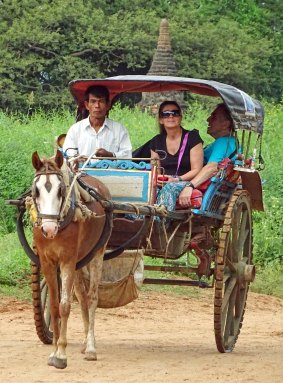
Horse-and-cart ride through the Kayminga Pagoda complex in Bagan.Credit: Brian Johnston
We trot along in horse-and-carts, cactus hedges on either side, flowering bean fields flung out like carpets in front of temples that invite an Indiana Jones scramble. The tracks are a bright slash of orange soil through green fields. Birds and butterflies flit. The carriage wheels creak, farmers thump-thump with their hoes, birds cheep from flowering acacia trees. At Damayangyi Temple, pungent-smelling bats squeak in the shadowy arches of its interior corridors. Here, more Buddhas in gold leaf and red-painted plaster smile from the shadows as they've done for a thousand years.
"To meet, to know, to love and to depart is the sad story of human life," observes Khin with sudden poetic whimsy. In truth, I'm not really ready to depart Bagan, but sail north back towards Mandalay we must. I clamber up the wooden gangplank and am offered a wet towel and glass of chilled fruit juice. I'm enfolded back into the embrace of Sanctuary Ananda, and onwards we go.
FIVE OTHER IRRAWADDY HIGHLIGHTS
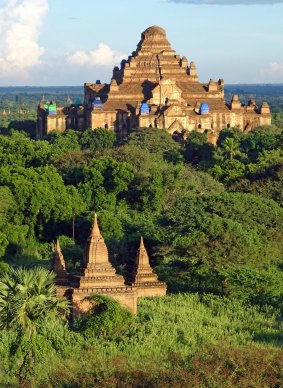
View of Bagan's temples from Sulamani Pagoda.Credit: Brian Johnston
Bagan is undoubtedly the top port of call on an Irrawaddy cruise, generally visited over two or three days. Here are five other destinations along the river.
PHWAR SAW VILLAGE
This village of 500 inhabitants on the outskirts of Bagan makes for an interesting Sanctuary Ananda shore-excursion visit, providing evidence that change is coming to Myanmar in its new houses and handicraft businesses. Tours visit a small manufactory of traditional medicine made from local plums, said to be good for cholesterol levels. Thousand-year-old methods for making lacquer are on show at a nearby lacquer-ware store.
MANDALAY
Myanmar's spiritual centre and last royal capital is centred on a vast, moated palace complex and surrounded by temple-dotted hills. From Su Taung Pyai Pagoda, 360-degree views take in the Irrawaddy's rice-planted valley and Shan Mountains. The city has numerous historical sights, glittering temples and a fruit-tumbled central market.
SAGAING
This town north of Mandalay has hillsides crammed with more than 500 temples and monasteries; multi-coloured Soon U Ponya Shin Pagoda provides the best river views along the Irrawaddy from its elevated terraces. The approach by ship is wonderful. With Sanctuary Ananda, you'll also be taken to a monastic orphanage school to meet some of its 2000 students.
AMARAPURA
Across the river from Sagaing, Amarapura is a large village – now almost a Mandalay suburb – noted for traditional crafts. If you're a devoted shopper or just interested in seeing craftspeople at work, then you can visit wood carvers, Buddha makers and textile workshops where women train for two years before being set before looms to create complex ceremonial silk longyis.
U BEIN BRIDGE
Shore excursions are timed to coincide with sunset at this famous wooden bridge across Taungthaman Lake near Amarapura to capture the silhouettes of pedestrians walking between a golden sky and gleaming water. After walking some of the bridge's length, take to a wooden boat and enjoy the sunset as champagne is served up by a cruise waiter.
TRIP NOTES
MORE INFORMATION
CRUISE
Sanctuary Retreats has various cruises on Sanctuary Ananda along both the Irrawaddy and Chindwin rivers in Myanmar, including the seven-night Mandalay-Bagan-Mandalay itinerary partly described here. Prices from $2240 per person twin share, including meals, guided excursions and port charges. Phone 03 9536 1831. See sanctuaryretreats.com
FLY
Malaysia Airlines flies from Sydney and Melbourne to Kuala Lumpur (8½ hours) with onward connections to Yangon (2½ hours). Phone 13 26 27. See malaysiaairlines.com
Brian Johnston travelled as a guest of Sanctuary Retreats and Malaysia Airlines.
Sign up for the Traveller Deals newsletter
Get exclusive travel deals delivered straight to your inbox. Sign up now.